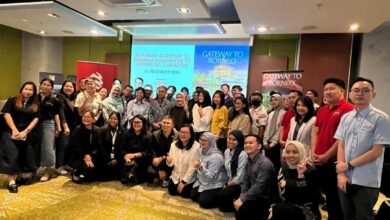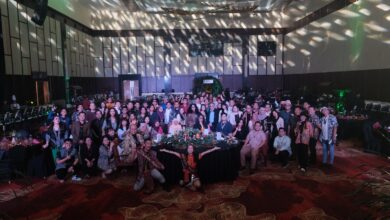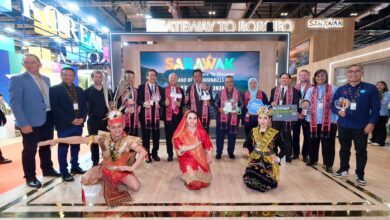Kuching: A UNESCO-Designated Creative City of Gastronomy

In the heart of Sarawak’s dense, mysterious forests, the flickering flames of burning wood logs cast a warm, inviting glow. Villagers gather around, preparing their evening meals in a scene reminiscent of ancient times. Back then, there were no modern pots and pans; instead, they used bamboo and anything that could hold food over the fire. Their ingredients were gifts from the wild—meat from hunted animals, fish from the rivers, roots, barks, leaves and other jungle produce. Despite these humble tools and ingredients, they crafted meals with unique, flavorful indigenous tastes.
Sarawak is home to 34 ethnic groups, each with its own culinary traditions passed down through generations. This rich diversity has given rise to many unique dishes, telling a story of its people and their connection to the land. Over the years, these traditional recipes have transcended the cooking grounds of tribal communities, finding their way into cafes and restaurants, delighting locals and tourists alike.
The remarkable diversity, ingenuity and unbeatable flavor of Sarawak’s cuisine captured the attention of UNESCO. As a result, Kuching, the capital city, was recognized as a Creative City of Gastronomy in 2021. This prestigious award celebrates the food, cultural heritage and vibrant culinary tapestry that make Sarawak a gastronomic paradise. Kuching is the first city in Malaysia to qualify as a member of UNESCO’s Creative Cities Network (UCCN).
This new status has brought international recognition to Kuching and has a tangible, positive impact on the city’s economy. It helps boost tourism, attracting more visitors eager to experience Kuching’s rich culture and culinary heritage. More tourists would help local businesses, including hotels, restaurants, cafes, markets and artisanal shops, fostering a sense of optimism and support for the city’s growth.
Being part of the Creative Cities Network opens opportunities for cultural exchange and collaboration and sparks excitement and inspiration for Sarawak’s people. We are now part of a global community, sharing ideas, experiences and best practices with other creative cities.
Our journey as part of the network is just beginning. We are committed to continuously seeking new opportunities for our local community, striving to provide better access to cultural experiences, especially for marginalized groups and integrating culture and creativity into our sustainable development plans. A Membership Monitoring Report is required every four years to ensure involvement in the network. It’s a great way to keep things fresh and exciting.
Culinary wonders for travellers


Source: Sarawak Tourism Board
As a tourist in Kuching, you can actively engage in the city’s gastronomic initiatives and immerse yourself in its vibrant food culture. Here are some delightful ways to participate:
1. Food tours and workshops
Join guided food tours that take you to local markets, street food stalls and hidden eateries. Learn about traditional ingredients, cooking techniques and the stories behind each dish. Some tours even include hands-on workshops to prepare your Sarawakian delicacies.
2. Visit local markets
Explore vibrant streets and markets such as Kuching Main Bazaar, Satok Weekend Market (Medan Niaga Satok), Petanak Central Market and Stutong Community Market. Interact with vendors, sample fresh produce and uncover unique ingredients. Chat with locals—they will be happy to share their food recommendations.
3. Cooking classes
Enroll in cooking classes to learn how to make iconic Sarawakian dishes. These classes offer an interactive experience and enable you to replicate the flavors, from laksa to kek lapis.
4. Attend food festivals
Look for food festivals and events. For example, the Rainforest World Music Festival includes a food component where you can enjoy a variety of cuisines while listening to live music and cultural performances. Another event to consider is the Kuching Festival Food Fair, conveniently located on the grounds of Kuching South City Council (MBKS), with over 300 stalls.
5. Support local restaurants and cafés
Opt for locally-owned restaurants and cafes. Discover local eateries in traditional villages (kampung). Try dishes beyond the usual menu; ask for recommendations from the staff or fellow diners.
6. Explore indigenous ingredients
Sarawak is known for its unique ingredients like wild ferns, bamboo shoots and sago pearls. Look for dishes that feature these elements and take the time to appreciate their cultural importance. There are even medicinal plants such as galangal, tapioca and Chinese motherwort.
7. Document Your Culinary Journey
Share your culinary adventures on social media using hashtags such as #kuchingcreativecityofgastronomy or #sarawakeats to connect with fellow food lovers and support local businesses.
Gastronomy extends beyond just eating—it’s about understanding the stories, traditions, and people behind the food.
Integrating traditional ingredients into meals

Source: Sarawak Tourism Board
Sarawak’s traditional food produce and ingredients provide a delightful culinary experience. Whether you’re a tourist or a local, here are some ways to incorporate these flavors into your meals
Explore unique ingredients like sago, which is extracted from the sago palm. You can use it in desserts and puddings or as a thickener for soups and stews. Try making a refreshing sago pudding with coconut milk, palm sugar and a hint of pandan flavor.
Asam paya, a tangy jungle fruit, adds a unique twist to dishes. Create assam paya sambal by blending the fruit with chillies, shallots and lime juice. Serve it as a condiment with grilled fish or rice.
Nibong, the young shoots of the nibong palm, are edible and can be incorporated into salads or stir-fries. Incorporate nibong shoots into a stir-fry vegetable medley with garlic, ginger and soy sauce.
Daun jampang is a wild fern found in Sarawak’s jungles. Make a simple wild fern salad with lime juice and a touch of salt.
Terung asam (sour eggplant) has a tangy taste. Prepare a terung asam curry by sautéing the eggplant with onions, garlic and tamarind paste. Serve it with steamed rice.
Kunyit kampung is a local turmeric variety. Grate fresh kunyit kampung to make a vibrant turmeric rice or add it to curries for color and flavor.
Tepus is an ingredient in the ginger plant family and is popular among sellers of jungle produce. Explore traditional recipes that incorporate tepus, such as tepid soup, stir fry or steaming freshwater fish.
Buah dabai, also known as Sarawak olive, is a seasonal fruit with a creamy texture and unique flavor. To prepare, soak the buah dabai in warm water until soft, then toss them with soy sauce, sugar and a bit of chilli for a tasty snack or side dish.
Buah keluak is a black nut with a rich, earthy flavor, often used in traditional Peranakan and Sarawakian dishes. Add it into a buah keluak chicken stew, where the nuts are cooked with chicken, spices and tamarind for a deeply flavorful dish.
Motherwort, a special herb with medicinal qualities, is commonly used to make Kacangma, a traditional confinement food for mothers after giving birth. To make a comforting and nutritious meal, fry the dried motherwort with chicken and simmer in Chinese cooking wine. Add seasonings such as salt and ginger and use some water.
Replace common herbs or seasonings with indigenous alternatives. In your recipes, experiment with tribal ingredients to create your own Sarawak-inspired dishes.
Support local farmers and ethnic communities
Buy from local markets, specialty shops, tribal villages, online platforms and food tours to support local farmers and indigenous communities cultivating these ingredients.
Some tours allow visitors to visit the villages. Here, they can learn and purchase local ingredients directly from the source. Some local farmers and indigenous communities may sell their products online or through social media. Look for local Sarawakian food groups or pages that promote traditional ingredients.
Join guided food tours that focus on traditional Sarawakian ingredients. These tours often include visits to markets and local producers, providing an opportunity to purchase ingredients directly. By exploring these options, you can enjoy Sarawak’s rich culinary heritage while supporting local farmers and indigenous communities.




